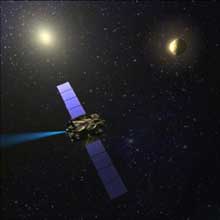
Stem cells have enormous potential for repairing damage to the body caused by disease, injury, or aging. When introduced into an injured area of a patient, a stem cell could survive and repopulate the region with different types of cells, forming normal tissue.
Stem cells also offer the prospect of treating many inherited diseases caused by a single, defective gene. Though other treatments are available, such as gene therapy, the longevity of benefits from stem cell treatment provides a tant

A group of anti-cancer agents that once produced dismal results in clinical trials could once again be a promising tool in fighting the deadly disease, thanks to research by a team of chemists at the University of Washington and in Germany.
The agents, called maytansinoids, were first discovered in the 1970s when scientists looked for tumor inhibitors in a rare Ethiopian plant. The same group of maytansinoids was later isolated from a new bacteria species. The compounds held great promise b

A new UCLA Neuropsychiatric Institute study shows for the first time that measurable changes in the front of the brain can predict the effectiveness of an antidepressant within days of treatment — weeks before a patient begins to feel better.
Using quantitative EEG, a non-invasive computerized measurement of brain wave patterns, the researchers discovered that specific changes in brain-wave activity precede clinical changes brought on by medication. The new findings, published in the July e

Depression investigators at The Research Institute of University Hospitals of Cleveland have zeroed in on the neurotransmitter serotonin, a brain chemical that regulates emotion. Their tactics: reduce serotonin levels in each study subject to learn who is vulnerable for developing major depression.
This new study, funded by the National Institute of Mental Health, is designed to help scientists better understand the role of serotonin in people who get major depression. By examining the way

A substance produced by tomatoes repels mosquitoes and other insects more effectively and is safer than DEET, the chemical most commonly used in insect repellents, a North Carolina State University scientist has discovered.
Indeed, work by Dr. Michael Roe, William Neal Reynolds Distinguished Professor of Entomology at NC State, showed that the natural compound found in tomatoes is so effective at repelling insects that the university patented the substance. The patent describes how the subs

As scientists demand more from space missions travelling to other worlds and beyond, traditional rocket technologies are beginning to show shortcomings. In response, ESA are helping to develop a new type of rocket engine, known as solar-electric propulsion, or more commonly, an ion engine, that can mark a whole new era of space exploration.
Solar-electric propulsion is ESA`s new spacecraft engine. It does not burn fuel as chemical rockets do; instead the technique converts sunlight into elec

– new calculation confirms standard model of particle physics. Contribution of hadronic vacuum polarization determined with unprecedented accuracy. The magnetic moment of the muon is an important precision parameter for…
Technique may prevent formation of unwanted waves that siphon off needed energy. Heating plasma to the ultra-high temperatures needed for fusion reactions requires more than turning the dial on a…

An international team of astronomers, led by researchers from the Astronomical Observatory of the University of Warsaw, have identified a new class of cosmic X-ray sources. The findings have been…

Antibody that Neutralizes Inhibitory Factors Involved in Nerve Regeneration Leads to Enhanced Motor Function after Acute Spinal Cord Injury. Researchers at 13 clinics in Germany, Switzerland, the Czech Republic and…

How the body’s natural killer cells could fight leukemia. Every year, some 13,000 people in Germany are diagnosed with leukemia. Despite intensive chemotherapy, around one in two of them die….

… eco-friendly reactor converts air and water into ammonia. Producing enough ammonia to feed the world comes with a large carbon footprint;. process described in new UB-led study could help…

How simulations help manufacturing of modern displays. Modern materials must be recyclable and sustainable. Consumer electronics is no exception, with organic light-emitting diodes (OLEDs) taking over modern televisions and portable…

“Neurons that fire together, wire together” describes the neural plasticity seen in human brains, but neurons grown in a dish don’t seem to follow these rules. Neurons that are cultured…

The quest for sustainable energy solutions has been a major focus of scientific research for decades. Solar energy, a clean and renewable source, has emerged as a promising alternative to…

With a processing speed a billion times faster than nature, chip-based laser neuron could help advance AI tasks such as pattern recognition and sequence prediction. Researchers have developed a laser-based…

New technology could remotely identify various types of plastics, offering a valuable tool for future monitoring and analysis of oceanic plastic pollution. Researchers have developed a new hyperspectral Raman imaging…

Artificial Intelligence (AI) has established a strong presence across industries, large and small. The “VoBaKI” research project has empowered small and medium-sized enterprises (SMEs) with an innovative tool to independently…